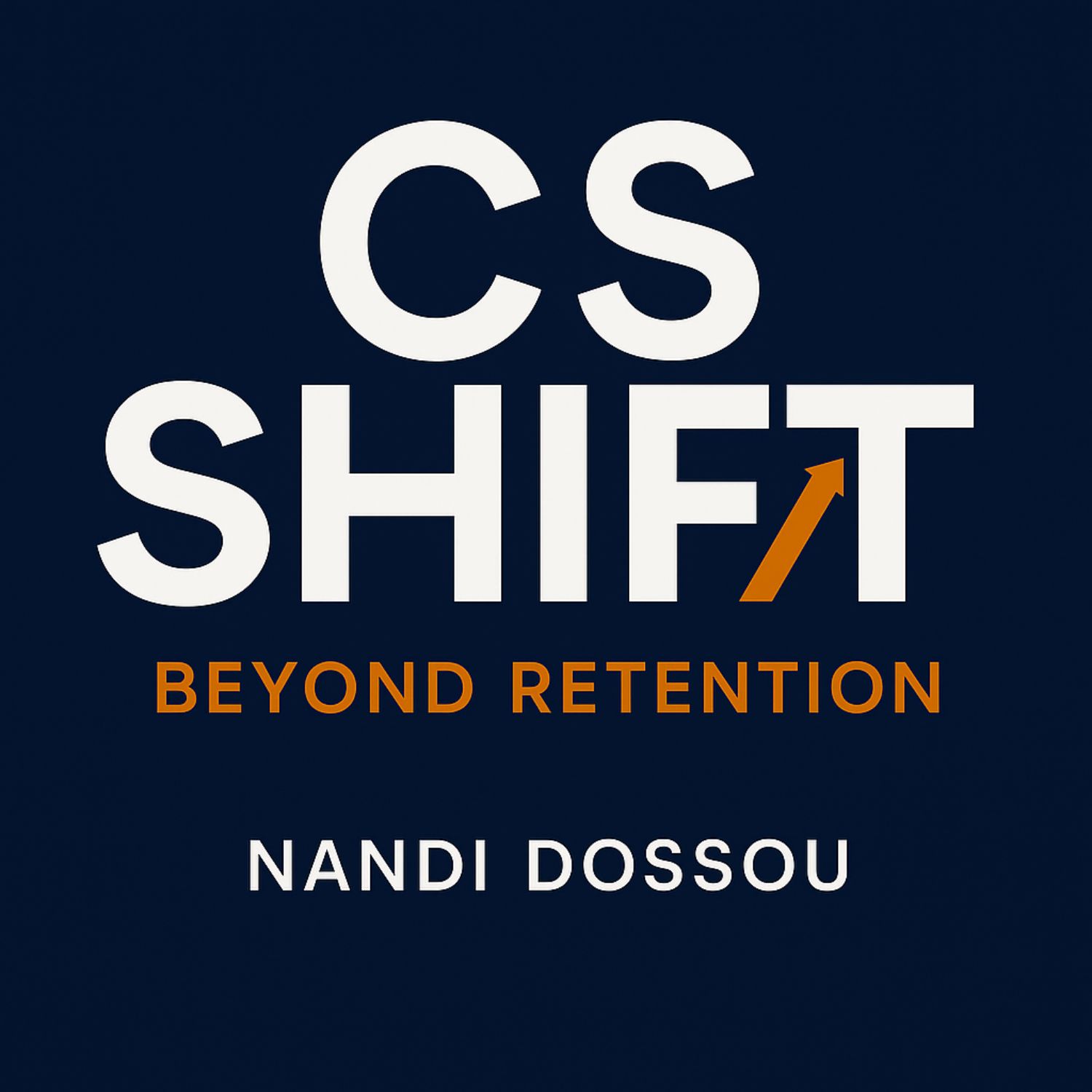From Promise to Proof: A Practical Framework to Prove the Value of Digital Transformation
🚀 Digital transformation isn’t about adopting tools, it’s about delivering measurable business outcomes.
In the first episode of my new podcast series,
🎙️ “From Promise to Proof: A Practical Framework to Prove the Value of Digital Transformation”,
I unpack:
- Why adoption ≠ value
- The common pitfalls teams face when trying to prove impact
- The first two steps of a practical Value Realization Framework you can apply right away
If you lead transformation, customer success, or enablement, this is for you.
Transcript
Welcome to CS Shift, the podcast that.
Speaker B:Goes beyond retention with strategists for customer success leaders navigating the new era.
Speaker B:Let's dive into today's episode.
Speaker A:Welcome back to CS Shift, the podcast that gives beyond retention with strategies for customer success leaders navigating the new era.
Speaker A:I'm Nanjito sue, your host and I'm very happy to welcome you in this new Siri.
Speaker A:I'm starting and before unveiling the subject of this new Siri, let me share two stories with you.
Speaker A:One day I was in a meeting a quarterly business reviews with some executives and adoption was very low.
Speaker A:Very, very low.
Speaker A:Adoption was at 30%.
Speaker A:It was a 1 million payer customer.
Speaker A:So can you imagine?
Speaker A:And then one of the C level told me, you know, if my employees don't see the value of using the solution, there is no point for us to invest next year into your offering another meeting another customer in that case.
Speaker A:Oh, the indicators were great.
Speaker A:I was almost bragging about how adoption was high, completion, license, activities, everything green.
Speaker A:And one of the execs look at the numbers and said okay, usage is great, but I've not seen anything moving up in our revenue the past six months.
Speaker A:So what is the impact of this usage on our bottom line?
Speaker A:Okay, what do I mean by these two stories?
Speaker A:Well, I want to share with you how as a CS leader you can start working in a way that will prove value realization and roi.
Speaker A:This is a big subject and a big topic because sometimes because we are so used to our metrics, we are so focused on those metrics of usage adoption, we fail to connect those leading indicators with what executives want to see.
Speaker A:And it's very difficult.
Speaker A:Renewing contracts is value is not proven.
Speaker A:What do you think?
Speaker A:Do you agree?
Speaker A:So executives don't buy projects, they invest in outcomes.
Speaker A:And today in this episode I want to share two elements with you.
Speaker A:The first one, I want to review the pitfalls we fall under improving value.
Speaker A:And also I want to share with you the two first steps in proving value realization.
Speaker A:Ready?
Speaker A:Fantastic.
Speaker A:So most transformation programs fall into one or more of the following traps.
Speaker A:Pitfall number one, it's about focusing on adoption only.
Speaker A:I'm not saying focusing on adoption.
Speaker A:I said adoption only.
Speaker A:So measuring logins, course completions or licenses activated without linking them to outcomes is a pitfall because if there is no ROI being proven, the customer might be at risk.
Speaker A:Pitfall number two is when we have no baseline or target outcomes, we lack before metrics to compare against post implementation impact.
Speaker A:And this is something which is also critical you know, with all the experience I had in the customer success field, one of the things I've generally started changing when I was starting a new role was really to look at the customer success plans the way they were built in order to create them in such a way that we have a baseline and a target outcomes Pitfall number three Lagging metrics only.
Speaker A:We don't want to wait for long term financial impact without tracking leading indicators.
Speaker A:Now one that will also resonate with you is pitfall number four Lack of business ownership.
Speaker A:Wow.
Speaker A:When transformation or initiatives or the product you deploying remains it only or remains HR led or remains in a specific business unit without accountability from the business units using your solution, this is also a pitfall to solve.
Speaker A:And last but not least, fragmented reporting usage data.
Speaker A:KPIs and financial impact are tracked in different places with no current story.
Speaker A:Knowing these common pitfalls, this can be a great way to start reviewing accounts with your team and identify the customers who will fall under each pitfall, if any, and starting designing solutions fully with the framework.
Speaker A:I'm going to share with you in order to start working on value realization.
Speaker A:That being said, now I want to share with you the two first steps you can take in order to prove value realization.
Speaker A:Number one, Define the Value North Star what is the purpose of defining the Value North Star is to encore the entire initiative on a clear strategic business outcome, not just deployment or licenses rollout.
Speaker A:Again, executives don't buy projects, they invest in outcomes.
Speaker A:So what it means?
Speaker A:It means that for what your solution is looking to solve, it's important to link that to a strategic business objective at your client side.
Speaker A:Maybe they want to accelerate the ramp up of their sales.
Speaker A:Maybe they want to reduce their time to market.
Speaker A:Maybe they want to be much more agile in the way they create their products.
Speaker A:Whatever it is, it's important to have the strategic business objective and also define a success horizon.
Speaker A:What success means to them and in which horizon?
Speaker A:Is it short?
Speaker A:Is it medium?
Speaker A:Is it long term?
Speaker A:This needs to be written and followed.
Speaker A:Now one thing very important.
Speaker A:You don't want to only know strategic business objectives.
Speaker A:You also want to know the business KPIs that are already tracked at the board level.
Speaker A:Is it revenue growth?
Speaker A:Is it gross margin?
Speaker A:Is it customer NPS?
Speaker A:Is it operating cost?
Speaker A:Knowing those KPIs might also help you.
Speaker C:Tie the benefits of your solution to those business KPIs.
Speaker C:Number two, identify value drivers.
Speaker C:Once you have the North Star, it's time to translate the North Star into measurable levers and the concrete areas where transformation creates impact and value drivers and more specifically in digital transformation will fall into four categories.
Speaker C:Revenue Uplift do we see an improved upsell parcel?
Speaker C:Faster time to market, Increased conversion, bottom line growth cost optimization?
Speaker C:Is there cost reductions?
Speaker C:Is there lower support costs?
Speaker C:Is there any process automation, risk reduction?
Speaker C:Do we see improved compliance, reduced downtime, enhance security or experience gains?
Speaker C:Do they see faster service delivery?
Speaker C:Improve employee productivity?
Speaker C:NPS uplift co design these value drivers with business stakeholders early because this gonna create a joint ownership we coming to.
Speaker A:The end of this first episode on this new series about value realization and Erro.
Speaker A:Hi, well this is CS Shift.
Speaker A:I'm Nandi Dosu and waiting to share with you the oversteps of proving value next week.
Speaker A:In the meantime, have a great week and enjoy your shift.
Speaker B:Thank you for listening to this show.
Speaker B:Remember, the new mandate for customer success is driving growth and growth does not happen in isolation.
Speaker B:It's driven by strategic and operational leadership.
Speaker B:Subscribe and share this episode with an overseas leader ready to shift their strategy today.
Speaker B:I'm Nandidosu and this is CS Shift.

